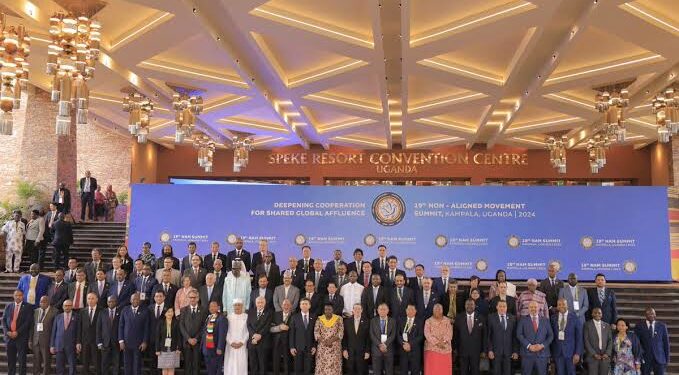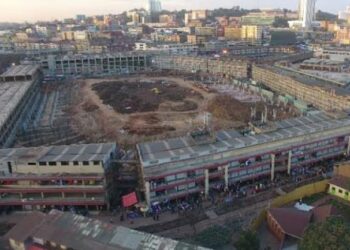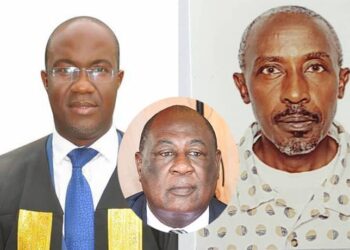In a monumental convergence of global leaders and diplomatic minds, Uganda proudly hosts the 19th Non-Aligned Movement (NAM) Summit.
Against the backdrop of the stunning landscapes and vibrant culture that define this East African nation, the 19th NAM Summit stands as a pivotal moment for international diplomacy, where nations gather to navigate the complexities of a rapidly changing world without succumbing to traditional alliances.
As the spotlight turns to Uganda, a nation whose rich history is interwoven with tales of resilience and progress, the 19th NAM Summit takes centre stage as a crucial forum for dialogue and collaboration. This summit encapsulates the spirit of the Non-Aligned Movement, emphasizing the importance of sovereign nations charting their destinies while fostering unity on matters of global significance.
Over 120 delegates are expected to attend this summit which is on it’s 3rd day.
However, what’s NAM and why do they hold a summit every after three years?
The Non-Aligned Movement (NAM) emerged in the aftermath of the Korean War, a response to the escalating bi-polarization of the world during the Cold War. As two major powers, the pro-Soviet socialist bloc led by the Warsaw Pact and the pro-American capitalist group under NATO, sought to pull nations into their orbits, leaders like Yugoslav President Josip Broz Tito, Indian Prime Minister Jawaharlal Nehru, Egyptian President Gamal Abdel Nasser, Ghanaian President Kwame Nkrumah, and Indonesian President Sukarno initiated the formal establishment of NAM.
The movement was founded during the Bandung Conference, which took place in Bandung, Indonesia, from April 18 to 24, 1955 and from 1st September to 6 1961 in Belgrade, Yugoslavia the first summit was held. NAM’s formation was to maintain the independence and sovereignty of its member countries by not aligning with any of the major military alliances of the time.
The principles agreed upon at the Bandung Conference in 1955 laid the foundation for NAM, and its primary objective, as outlined in Fidel Castro’s Havana Declaration of 1979, was to safeguard the national independence, sovereignty, territorial integrity, and security of non-aligned countries. NAM aimed to combat imperialism, colonialism, neo-colonialism, racism, and foreign aggression, striving against great power politics and bloc hegemony.
Comprising nearly two-thirds of the United Nations’ members and representing 55 per cent of the world population, NAM has a significant presence, particularly in developing countries. While initially gaining traction in the 1950s and 1960s with notable successes in decolonization, disarmament, and opposition to apartheid in South Africa, the movement persisted throughout the Cold War. Despite conflicts among members and some aligning with major powers, NAM endured.
Following the end of the Cold War in 1991, NAM adapted its focus to developing multilateral ties and fostering unity among developing nations, especially those in the Global South. Emphasizing collaboration, NAM seeks to address contemporary global challenges, leveraging the collective strength of its diverse membership.
Membership
The first countries to join the Non-Aligned Movement (NAM) were those that participated in the Bandung Conference in 1955. The Bandung Conference marked the formal beginning of the movement, and the participating countries were from Asia and Africa, and they shared a common goal of promoting a neutral stance during the Cold War.
The following 29 countries attended the Bandung Conference and can be considered among the first members of the Non-Aligned Movement:
Afghanistan, Burma (now Myanmar), Cambodia, Ceylon (now Sri Lanka), Egypt, Ethiopia, Gold Coast (now Ghana), India, Indonesia, Iran, Iraq, Japan, Jordan, Laos, Lebanon, Liberia, Libya, Nepal, Pakistan, People’s Republic of China, Philippines, Saudi Arabia, Sudan, Syria, Thailand, Turkey, Vietnam, Yemen and Yugoslavia. These nations came together to assert their independence, promote economic development, and maintain a neutral stance in the Cold War. Over time, the movement has expanded, and additional countries joined, broadening its representation to include nations from different regions around the world.
Uganda, the country which is hosting the ongoing summit, joined the movement shortly in 1962 after gaining independence. As one of the early members of the movement, Uganda aligned itself with the principles of non-alignment, seeking to assert its independence and pursue its own development path without aligning with any major power bloc during the Cold War. As of now Africa as a continent has 53 member countries in NAM, the Americas and the Caribbean have 26 countries, Asia and Pacific 44 while Europe has only two countries; Azerbaijan and Belarus.
Turkey played a pivotal role in the formation of the Non-Aligned Movement, but unlike other member countries, it did not officially join the movement. Instead, Turkey adopted a foreign policy that involved NATO membership and alignment with Western nations. Since becoming a member of NATO in 1952, Turkey has maintained strong ties with its Western allies.
The People’s Republic of China and Japan, while not members of NAM, have pursued their own foreign policies independent of alignment with any particular bloc. China, for example, was never aligned with either the Western or Eastern bloc during the Cold War. Japan, on the other hand, has generally maintained close ties with the United States through its security alliance but has also pursued a policy of non-alignment in a formal sense.
Yugoslavia, which hosted the inaugural summit, is no longer a member country as it ceased to exist after its dissolution in the early 1990s. This breakup led to the emergence of several independent nations including Kosovo, Bosnia and Herzegovina, Croatia, and Montenegro, among others.
The successor states of Yugoslavia have shown limited interest in NAM membership, with only Slovenia, North Macedonia, and Kosovo actively participating. The remaining states Bosnia and Herzegovina, Croatia, Montenegro, and Serbia maintain observer status. India, a founding member, seems to have reduced its focus on the Movement.
Bosnia and Herzegovina’s and Costa Rica’s membership applications were rejected in 1995 and 1998, respectively. In 2004, Malta and Cyprus ceased to be members upon joining the European Union, as required. The most recent additions, Azerbaijan and Fiji, joined in 2011. Notably, Azerbaijan and Belarus, which joined in 1998, are the sole NAM members located in Europe.
This marks the 19th summit since the formation of the organization, with Uganda becoming the sixth African country to host such an event. Notably, Yugoslavia holds the unique distinction of hosting the summit twice, in 1961 and 1989.
Do you have a story in your community or an opinion to share with us: Email us at editorial@watchdoguganda.com













